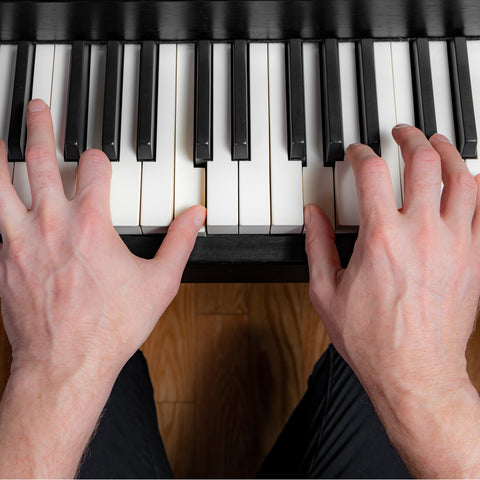Piano Hand Position Games

Lesson 23: Piano Hand Position Games
There are many factors affecting a child's ability to have their hands in the "correct" position. Just to be clear, the "correct" position is hands flat, and forearms level with the keys.
Here are the factors that may make proper hand position impossible:
- The age of the child: some younger kids can barely sit on the piano bench.
- The height of the piano and the height of the chair/bench: you can't have forearms level if either of these are not right.
A never-ending dilemma for children’s piano teachers is how to teach children the “proper” hand position.
From my experience, force does not work. Enlightened, theatrical demonstration does.
Here are games you can play that will naturally give your beginning students an abstract idea of how the hand must be positioned.
The Hobbita-Jobbita Game
This is a game that shows the child how to release the muscles of the hand. Have you ever noticed how a child’s hand will contort (with tension) the moment they touch or approach the keys? This is human nature. Difficulty makes us tense, and it is always reflected in the shoulders and the hands.
Accept this tension, and use the game below to give the child an abstract idea of how the hand should feel AWAY from the keyboard.
- Take both hands and put them at your side. Then wildly shake them in place, at arm’s length. As you do this, say, “Hobbita jobbita, hobbita jobbita” repeatedly. Make it funny. Make the child say it. It should sound like a funny sound out of a cartoon.
- Then suddenly command them to stop. Point out their hands to them before they have a chance to tighten the muscles.
- Hold their hand and show them how loose the fingers are, how gently curving they are. Just make them observe this effect.
- Their immediate reaction will be to tense their fingers into a claw, (if for no other reason than to playfully make you laugh) but you have a few seconds before this occurs to them.
- Do this over and over, until they are willing to leave the hand relaxed. Then, continue and place their relaxed hand on the piano, right around Middle C.
If you do the last step enough times, they will retain the image and feel of how their hands are supposed to be. They will not always, or ever, live up to this ideal of hand position, but at least they know what it is. Usage and fingering will eventually make their fingers fall into this position naturally.
Try to get students to distinguish between fingers that are stiff, “breadsticks,” and fingers which are loose, “noodles.” Give them some mental image of the difference, and play games with their fingers using those terms.
Piano Is Easy
The Quarters Game
After a child has had an introduction to fingering, and can retain the five fingers in a row on the keys for even a few seconds, try this game.
- Balance a quarter on the back of the child’s (right) hand.
- Ask them to play the five fingers in a row, starting with the thumb. They will enjoy the game of making the quarter stay on their hand.
- Yes, the quarter will fall off and roll on the floor, and most likely be lost under the piano or furniture. Laugh. Bring extra quarters. It’s a game.
Hand position comes naturally from games such as these. Concentrate on songs that leave the hand in one, easy to grasp position. Do this until the child is thoroughly familiar with the physical sense of how the hand lays on the piano.
Fitting Hand Position Into Your Curriculum
I insist on the notes first, with whatever fingers are easiest (kids also offer the toes, the nose.) Then, when they have some idea of the pattern of notes, suggest a fingering or two and show how it will allow them to play faster. Playing faster is what children want to show off to others. Get them to connect fingering and speed. When I play for a child, they are dazzled by how fast I can play. They always ask, “How do you play so fast?” I answer invariably with one word: fingering.
Next, introduce the idea of hand position, and show how it will make them move even faster. Hand position allows you to move faster because there is no wasted time with fingers too far from the keys. Find the things that a child wants from the piano, such as speed, and show them how to get it using games.
COURSE ONE: TEACHING TOOLS
#2 WHAT A CHILD SHOULD EXPECT FROM PIANO LESSONS
#3 WHAT IS FINGERING AND WHEN DO WE USE IT
#4 PIANO BY NUMBER AND OTHER STARTING METHODS
#6 MINUTE BY MINUTE PIANO LESSON
#7 TOYS AND ACCESSORIES FOR FUN PIANO LESSONS
#8 READING MUSIC FOR KIDS STEP BY STEP
#9 THE DIFFERENCE BETWEEN WORST AND BEST TEACHER
#10 A CHILD’S CLASSICAL MUSIC LISTENING LIST
COURSE TWO: TEACHING BACKGROUND
#11 A SHORT HISTORY OF THE PIANO
#12 A SHORT HISTORY OF PIANO METHODS
#13 A PLEASANT PIANO LESSON ATMOSPHERE
#14 ADVICE TO A YOUNG PIANO TEACHER
#16 A PIANO TEACHER’S EMOTIONS
#17 PACE AND CHILDREN’S PIANO LESSONS
#18 CHILDREN’S PIANO MOTOR SKILLS DEFINED BY AGE
#19 CHILDREN’S PIANO FINGERING OVERVIEW
#20 GUILT IS THE WRONG WAY TO BUY ATTENTION
COURSE THREE: PIANO GAMES
#21 FOURS, A PIANO COUNTING GAME
#24 THE USE OF HUMOR IN PIANO LESSONS
#25 HAPPY OR SAD: EAR TRAINING FOR KIDS
#26 FOLLOW THE LEADER: VISUAL PIANO GAMES




